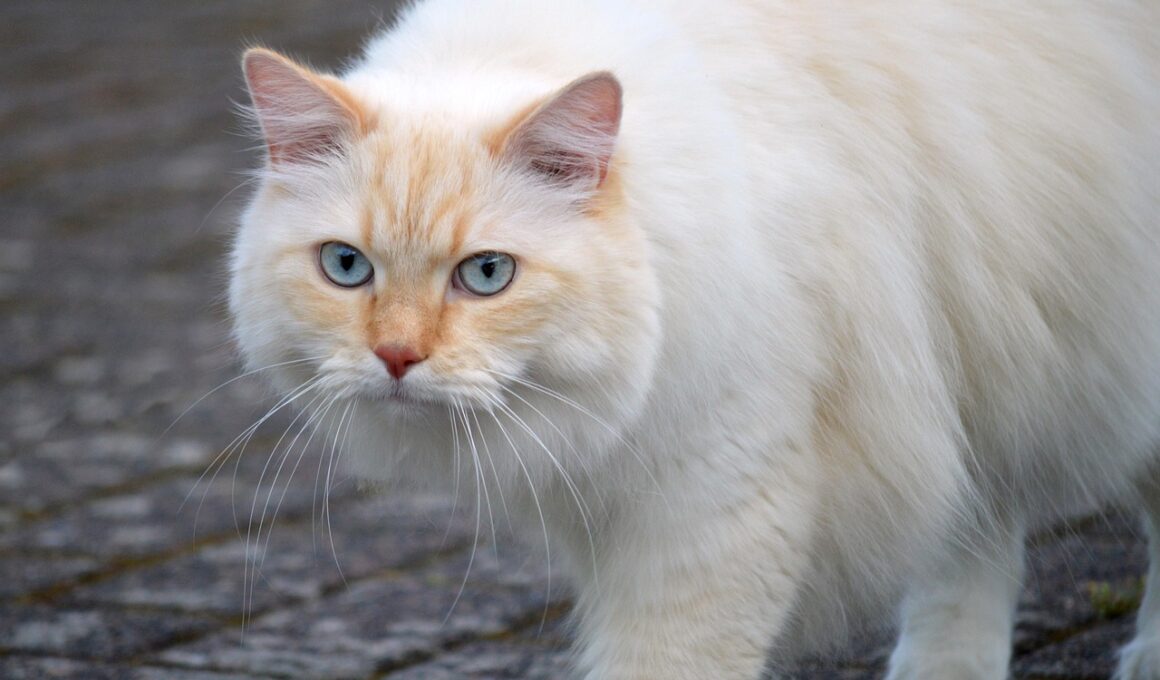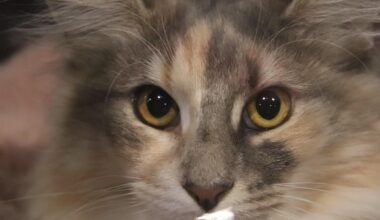The Impact of Cat Shows on Cat Health and Welfare
Cat shows provide a unique space not only for showcasing feline beauty but also for promoting overall health and welfare of cats. These events attract breeders, pet owners, and judges who share a common affection for cats. By participating in cat shows, breeders can learn best practices, engage in discussions, and exchange vital information regarding feline health. These exchanges often illuminate essential topics such as genetics, nutrition, and overall care, empowering breeders to make informed decisions. Additionally, networking with veterinarians and pet care specialists at these events leads to better health outcomes for both show and non-show cats. Notably, cat shows offer a platform for education, allowing attendees to attend lectures and workshops that focus on critical health subjects. Participants have the opportunity to explore various breeds, noting health trends, which in turn can guide breeders in better breeding practices. Furthermore, competitive environments in these shows can inspire owners to maintain rigorous health and grooming regimens for their pets. Ultimately, cat shows serve as beneficial events that significantly enhance the health consciousness of cat owners and breeders alike, advocating for better feline welfare initiatives.
Engagement at cat shows often leads to rigorous standards in breeding practices. This encompasses not only the aesthetics of the cats presented but also their overall physical condition. Judging criteria at these events often consider health attributes, including weight, coat quality, and behavior. Therefore, owners are motivated to adhere to strict health guidelines for their cats leading up to the event. The pressure to showcase a healthy cat during competitions promotes regular veterinary check-ups, vaccinations, and proper nutrition. Moreover, owners are increasingly aware of the significance of breeding practices in maintaining good feline health. As cat shows continue to gain popularity, there’s a parallel rise in awareness of hereditary health issues associated with certain breeds. This awareness can help breed enthusiasts identify and rectify potential health concerns in their breeding programs, ensuring healthier offspring. Promoting health visibility through cat shows can lead to improved genetic diversity and reduced prevalence of hereditary ailments. Such initiatives ultimately yield benefits that resonate beyond the show ring and contribute to the overall well-being of the cat population. Consequently, health education at these gatherings plays a pivotal role in driving a widely responsible breeding culture.
Psychological Benefits of Cat Shows for Participants
The atmosphere at cat shows not only highlights the physical attributes of cats but also fosters a community among participants. This environment can be incredibly invigorating, providing a sense of belonging and camaraderie among cat lovers. Engaging with fellow participants about shared passions can offer emotional support and encouragement. Attendees often develop friendships that enhance their experiences. Moreover, the excitement from showcasing a well-trained cat can evoke a sense of pride and accomplishment for owners and breeders alike. Many cat owners report feeling motivated to improve their practices or delve deeper into breed-specific characteristics. The companionship fostered in these settings encourages a proactive approach towards the health and welfare of their feline companions. Additionally, witnessing other cats can inspire attendees to take better care of their pets, leading to improvements in their health and grooming routines. Consequently, the motivation instilled from these shows extends far beyond the competition. Each encounter contributes positively to both mental well-being and commitment to responsible pet ownership. Ultimately, the social impact of cat shows can significantly influence health and welfare outcomes for participating felines.
In discussing the benefits of cat shows, one must also consider the contributions made towards spaying and neutering initiatives, which are vital for feline welfare. Cat shows often advocate for responsible breeding and pet ownership, emphasizing the significance of population control. Organizations participating in these events may host booths or discussions focusing on the importance of spaying and neutering. This leads to heightened awareness among participants about the preventative measures necessary to combat the overpopulation problem. Attendees are encouraged to take action by learning about local resources for these critical services. Several events provide information on the health benefits associated with early spaying or neutering, which include reducing the risk of specific cancers and improving behavioral traits in cats. The initiative drives home the message that being a responsible breeder or owner extends beyond the show ring. Engaging potential cat owners in this aspect not only makes personal cat ownership more fulfilling but also contributes positively to community welfare. Overall, cat shows play a crucial role in spreading awareness and fostering responsible feline practices, ultimately improving the health of cats everywhere.
The Role of Veterinarians in Cat Shows
Veterinarians play a significant role in supporting the health and welfare of cats showcased in these events. Their presence ensures that animals are healthy, with many shows requiring certifications of health and vaccination before participation. Cats must undergo thorough evaluations by veterinarians, which helps identify any potential health issues prior to competition. This practice safeguards the welfare of all felines present and promotes healthcare transparency. Additionally, veterinarians often participate in discussions and workshops, providing valuable education to cat owners and breeders. These sessions aim to address prevalent health issues and promote preventive healthcare practices. Emphasizing regular check-ups and vaccinations to attendees underlines the necessity of responsible ownership. In some cases, veterinarians can assist with breed-specific medical problems, thereby enhancing the well-being of cats at the shows. The involvement of veterinary professionals promotes an overall healthier environment and stimulates discussions regarding breeding practices. As these professionals are actively engaged in outreach during events, they foster a greater understanding of feline healthcare among participants. Ultimately, the content and expertise they provide can lead to significant improvements in overall cat health.
Notably, cat shows also create avenues for rescue organizations to advocate for adoption. Many shows now incorporate adoption days or promote feline welfare organizations among attendees. This initiative directly contributes to the well-being of cats that need homes, bringing awareness to the importance of adopting over purchasing. By showcasing the benefits of adopting rescue animals, show organizers contribute to changing societal perspectives regarding cat ownership. Outstanding success stories and the presence of adorable homeless cats often encourage attendees to consider adoption. Emphasizing this aspect highlights how responsible cat ownership goes beyond the show ambiance. Various partner organizations provide resources and solutions for attendees wishing to adopt. This opportunity not only raises awareness about animal welfare but also directly contributes to enhancing the lives of cats that were previously homeless. The ripple effect of these actions fosters a sense of community responsibility among cat owners. By promoting positive change, the overall health and welfare of a larger feline population can be improved. Cat shows thus play a significant role in advocating for the overall well-being of domesticated cats in various communities.
Conclusion: Cat Shows as Champions of Feline Health
In conclusion, cat shows significantly impact feline health and welfare through education, engagement, and advocacy within the cat breeding community. By fostering interaction between breeders, owners, and veterinarians, these events create an ecosystem of knowledge where health practices can flourish. Participants are empowered to elevate their breeding standards and overall care regimens for their cats. These shows promote the importance of routine health checks, leading to healthier kittens and adult cats. Furthermore, they amplify veterinary involvement in feline health advocacy, reinforcing the need for preventive care. The societal benefits of cat shows extend to local rescue organizations, encouraging adoption and promoting awareness around feline welfare initiatives. Each event serves as an opportunity to build a stronger community of responsible pet owners and breeders. Ultimately, the benefits of these gatherings profoundly influence the conscientious practices adopted by defiantly loyal cat enthusiasts. Therefore, cat shows emerge not just as competitions but as a vital part of promoting and safeguarding the overall health and well-being of cats globally, showcasing how competition can lead to compassionate care in the world of felines.
Furthermore, the excitement surrounding cat shows creates a dynamic platform for sharing knowledge and experiences, which contributes positively to feline health standards. Participants often exchange best practices, learning from one another’s successes and challenges. This supportive environment nurtures continuous improvement and innovation in breeding practices. By fostering an atmosphere of learning, cat shows inspire owners to prioritize the health of their felines before and after competitions. Many participants then take what they learn back to their local communities. This helps create a ripple effect, fostering a culture of responsible cat ownership that aligns with best health standards. Engaging with fellow attendees at these events often provides a sense of accountability among breeders and owners. The desire to present healthy and well-cared-for cats becomes a priority. Moreover, raising awareness about health concerns specific to certain breeds can lead to collective efforts towards solving these issues, influencing wider breeding policies. By championing responsible practices and encouraging open dialogue, cat shows become influential players in promoting elevated health standards. They help create a community dedicated to the welfare of cats, showcasing a collaborative commitment to enhancing feline well-being across the board.


